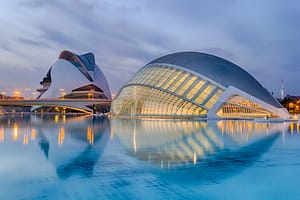The city of Valencia was founded in the year 138 B.C. By the Romans. They started by building the Forum in the Plaza de la Almoina (to be found in Valencia’s old town – El Carmen). In 714 the Visigoths arrived in Valencia after the Romans and Muslim rule was established in the city. This continued until 1238 when King Jaime I expelled the Moors from the city. The Moors may have been banished from the city, but they left a mark that remains to this day in the artistic influences, recipes and water system to be found in the city.
The Golden Era of Valencia is said to be during the 14th and 15th centuries in Valencia. This was a time when the economy flourished due to agriculture and maritime trade. This meant that lots of emblematic buildings were constructed during this period. The buildings include the Valencia Cathedral, the Torres de Serrano, the Torres de Quart and the Silk Exchange (called La Lonja). During this period there was also a surge in the arts – meaning that it has been coined the Renaissance period. During this time the Palau de la Generalitat was built – this is the building that is now the headquarters of the Valencia Regional Government.
Other buildings that are considered to be important from this period include the Basilica of the Virgin de los Desamparados, the Marqués de Dos Aguas Palace, Plaza Redonda and the San Pio V Museum of Fine Arts – these date from the Baroque era and the period of Enlightenment.
Another period that is of significance to Valencia history is the creation and continuation of Modernism. This is an architectural style that was pioneered by the likes of Gaudí in the twentieth century. It can be distinguished by its use of organic forms (many influences are taken from nature) teamed with art nouveau styles.
Valencia is one of the Spanish cities with a fair number of Modernist buildings. Buildings that are of note include the Estacion del Norte train station, the Mercado Central and the Mercado de Colon. The Mercado Central is the largest market building in Europe, covering 8,000 square metres and with 1,500 food stalls. The Palacio de la Exposicio is also worth checking out.
If you are a real fan of Modernist architecture, you will find less formal versions of it in the residential area of El Cabanyal, near the beach. For full details, see our Photo Route of El Cabanyal. Today, it is a powerhouse of modern culture and innovation, and with museums, art galleries, concert halls and the opera house of Valencia it plays an important part the cultural life of Europe as a whole. Two languages are spoken in the region. Spanish (or Castilian) and Valencian, both of them stemming from Latin. The origins of the latter are disputed, with some claiming that the language was formed from Latin during the Arab period in the region, whilst others saying was brought by Aragonese and Catalan troops and population, during the “Reconquista” period, but it has its own distinctive function in forming the character of the region, many schools and universities now use Valencian alongside Spanish as language of instruction.
The rich cuisine of the area is one of the most vivid manifestations of the heterogeneous elements which compose Valencian history. The Moors introduced advanced irrigation systems and planted, sugarcane, oranges and rice, with the paddy fields of the coast changing the landscape in a lasting way. Valencian Paella, Valencia. Photo by Valencia Tourist BoardThe Valencian paella, famous throughout Spain, was first made here more than a thousand years ago, and today rice is a staple in restaurants and homes throughout the region.
The award winning structures based largely on designs by Valencian born architect Santiago Calatrava and Spanish architect Félix Candela have become the cultural emblems of the city in their own right.

